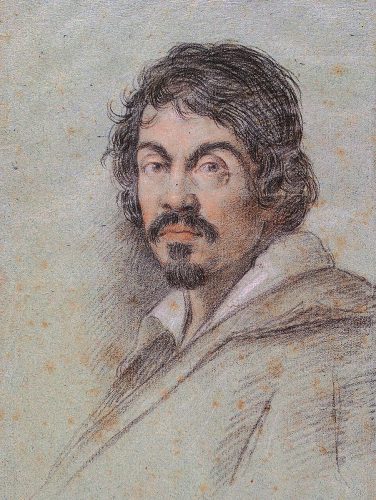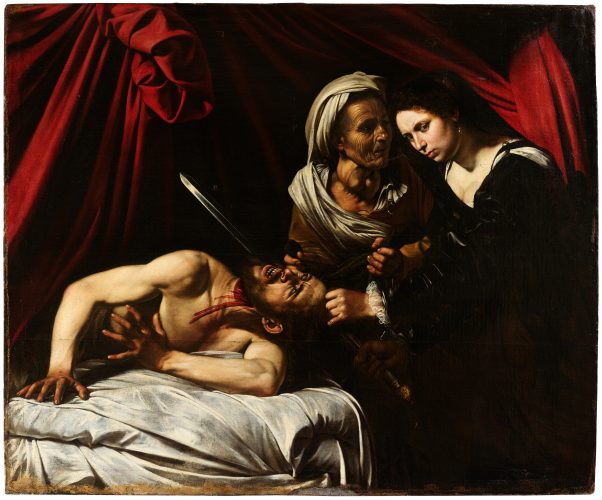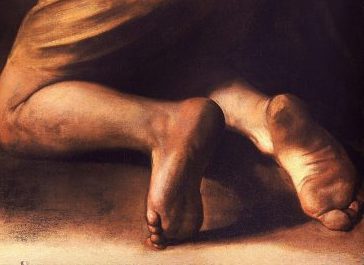The Caravaggio's lost masterpiece, Judith and Holofernes, was put up for sale in Toulouse by Marc Labarbe in 2019. This work, lost for more than 400 years, was discovered in an attic in Toulouse in April 2014 and estimated at between 100 and 150 million euros. Classified as " National Treasure " by the Ministry of Culture in 2016, its price led the State to renounce its acquisition, thus allowing it to be put up for auction.
Lost since the 1600s, this major painting by Caravaggio was found in an attic in Toulouse, in conditions as unexpected as they were incredible. After two years of restoration, the work was able to be presented in an optimal state of conservation, ready to be the subject of a prestigious sale.
Exposed to London, New York, Milan and Paris prior to its sale by our house, this work has attracted the attention of collectors and art enthusiasts around the world.
The painting depicts the biblical scene where Judith, heroine of the city of Bethulia, beheads the Assyrian general Holofernes, with the help of his servant AbraThis theme had already been treated by the Italian master in another work, preserved at the Palazzo Barberini in Rome, but this second version, darker, blacker, more brutal, revealed a new facet of the painter's genius.
The painting discovered in Toulouse was not, however, completely unknown, since a copy of this masterpiece, attributed to Louis Finson, was kept at the Intesa Bank in Naples. A conference of specialists concluded that the Neapolitan painting was undoubtedly a copy of a lost Caravaggio. Not for much longer! In April 2014, the original was rediscovered by Marc Labarbe in Toulouse.
The story of Judith and Holofernes went back to theyear 1607. According to several historical records, the painting was lost after being offered for sale in Antwerp in 1607, before disappearing unexplainedly. It was not found again until 2014 In Toulouse, in an attic where it had escaped a burglary a few years earlier. This work of art had survived several centuries of history, retaining its mystery before finally emerging into the light of day.
Caravaggio's work has been estimated at between 100 and 150 million euros, a price justified not only by its rarity, but also by its exceptional state of conservation.
The auction house The beard had the honor of managing this exceptional sale, from its discovery to its sale, proving, if proof were needed, its expertise in selling exceptional works of art.
In-depth analysis of the table
Comparison with other works of Caravaggio
1. JUDITH AND HOLOPHERNE BY CARAVAGE

The scene is recounted by a biblical text, the Book of Judith composed in Palestine towards the end of the 2nd
century BC JC.
The action is in 800 BC. Judith lives in Bethulia, a city besieged by
Holofernes. While the city is exhausted, ready to surrender to the enemy, Judith, a young widow of great beauty,
decides to seduce General Holofernes. He organizes a banquet in his honor. At the end of the
evening, he falls asleep drunk in his room. Judith then kills him with two sword strokes.
"In the evening, his servants hastened to leave each home, and Vagao closed the doors of the room and departed. All were asleep with the wine they had drunk. And Judith was alone in the room. Holofernes was lying in his bed all overloaded with sleep by the excess of wine. And Judith commanded her servant to stand outside the door of the chamber, and to watch there. Praying with tears, and stirring her lips in silence, she says, " Lord God of Israel, strengthen me, and see you
favorable at this moment that my hand will do so that you will meet, according to your promise, your city of Jerusalem, and that I finish what I thought I could do by your assistance ". Having spoken thus, she approached the column which was at the bedside, and untied her saber which was attached to it. Then, taking it from the scabbard, she took Holofernes by the hair of her head and said: Lord God, strengthen me at this time ". She then struck him on the neck twice, cut off his head; and having drawn a curtain out of the pillars, she threw down her dead body.
- Holofernes, lieutenant of the immense army of Nebuchadnezzar, king of Babylon, who besieges Bethulia in Samaria.
- Judith, literally "the Jewess".
- Abba, the maid of Judith.

Three ancient testimonies refer to paintings of Caravaggio representing Judith and Holofernes.
- The painter Giovanni Baglione (1566 - 1643) deals in his writings with a painting belonging to the banker Ottavo Costa.
- A letter dated 17 September 1607 from the Flemish painter Franz Pourbus (1569 - 1622) evokes a painting painted in Naples by Caravaggio.
- The Flemish painter Louis Finson (1580 - 1617), who bequeaths on November 19, 1617 a canvas on this subject to his disciple Abraham Vinck.
These testimonies are proof that Caravaggio executed several versions of this episode of the Bible.
Nowadays, we are aware of two versions:
- Judith and Holofernes, version of Rome. Order of Ottavio COSTA.
- Judith and Holofernes, version of Naples. Until now known by a copy, recognized as such, attributed to the painter Louis Finson (1580 - 1617).
In both versions, horror increased by:
- the confinement of the scene
- the disproportion between frail Judith and the gigantic Holofernes
- the hideous and grimacing maid
The choice of the moment.
In both versions, the choice of the moment breaks with the tradition, which consisted rather in recounting the preliminary of the murder when, during the banquet, Holofernes was seduced by Judith. Here is shown the now infigurable and central moment, the sword stroke being given, the blade midway, in the middle of the neck, the head that begins to separate from the body, pulled back by the hair that Judith's hand grips and the blood streams.
Unique moment, decisive, mortal, without past, without future: timeless. Judith will never stop cutting off Holofernes' head.
The table discovered in Toulouse is admirable both for its technical and aesthetic qualities. Confronted with the painting of Judith and Holofernes kept in Rome but also to the copy made by Louis Finson after an original Caravaggio, kept in Naples, it becomes very complicated to say that this painting can be in another hand than from that of Caravaggio.
Caravaggio, life and work

Leading a dissolute life with brawls, murders and leaks, her mysterious personality continues to fascinate us today.
Died before he was 39, he enjoyed outstanding celebrity status despite his more than controversial style.
Caravaggio will impose, not without setbacks and conflicts, his will of renewal and of invention, never ceasing to associate the sacred with the profane to nourish his imitation of the natural. He refuses the rhetorical hierarchy between noble subjects and low subjects. The radically innovative nature of his art played a decisive role in the affirmation of the principles of realism, from the very beginning of the seventeenth century.
Caravaggio "Destroyed all the good uses of painting Giovanni Pietro BELLORI (1613 - 1696).
" With Caravaggio, destruction of the painting means death of the painting of history, in a dark room through which a burst of light that captures, immobilizes, stupefies the figures in an instantaneous time, which neutralizes the duration of the representation in painting ". Louis MARIN (1931 - 1992).
Caravaggio and its context
Artistic time is governed by the precepts of the Catholic Counter-Reformation (Council of Trent, 1545 - 1563). In response to Protestantism, the Counter-Reformation wants to extend the practice of Catholic worship to a wider range of people. Artists are responsible for designing their work from a "propaganda" perspective by making religious art accessible to ordinary people. Images become "instruments for uniting men to God". The taste of Caravaggio's realism coincides with this desire to pay more attention to the most modest, and to reconcile devotion and communication.
The sponsors of works: priests, nobles or all honored persons who wish to beautify churches or persons practiced in the field of letters and studies.
Caravaggio will deal mainly with sacred subjects. The nature of the work entrusted to him was often intended for places of worship, but always financed by private persons. He revolutionized religious art by his very realistic approach, human and daily representation of biblical texts that could also shock the reformers. Thus, the painting The Death of the Virgin, painted with the main model the corpse of a drowned prostitute was refused by the clergy of the Church of Santa Maria della Scala in Rome.

In Italy, especially in Rome, it is the time when the mannerism It is a must for religious buildings with artists such as Girolamo MUZIANO (1532 - 1592), Federico BAROCCI (1528 - 1612) and Federico ZUCCARI (1539 - 1609).
Annibal Carrache (1560-1609), working with his brothers, Ludovico and Agostino, academic painter par excellence, advocates a painting based on the ancient models and the looking for the beautiful ideal. It embodies a school of painting that will tend to another interpretation of the precepts of the Council of Thirty: where Caravaggio will opt for a naturalistic vision and a representation based on popular models, the Carracci do not move away from so-called "classical" models. creating paintings by means of a clean drawing, and at the disposition and the balanced colors.
It is in the studio of Simone PETERZANO (Bergamo v. 1540 - Milan 1596), a Lombard artist, that Caravaggio, entering there at the age of 12, acquires the first rudiments of his training as a painter. PETERZANO is considered one of the best representatives of Late Lombard Mannerism. Caravaggio will paint during these four years of learning a significant number of portraits.
His manner is set up very early in his career, in his twenties. He arrived in Rome in 1592.
- 1592: Dejected and unknown, he enters the studio of Lorenzo Sicialiano, near Campo Vaccino, where he will paint "heads".
- End of 1592: He is hired in Rome by a painter named Antiveduto Grammatica, in his studio near the church San Giacomo in Augusta. At this time appears in his painting the "stereotype of the androgynous" (Young boy peeling a pear, Young boy bitten by a lizard, sick Bacchus ...).
Ill. Boy with fruit basket, circa 1593, Borghese Gallery / The young sick Bacchus, circa 1593, Borghese Gallery. / Young boy bitten by a lizard, 1595-1596, National Gallery, London.
- June 1593, entry to the workshop of "Cavalier d'Arpin", the most prestigious of Rome, organized on the model called "alla Torretta": distribution of tasks according to collaborators, some painting landscapes, others garlands of flowers according to their merit and experience ... He will leave this workshop in January 1594 in troubled circumstances; Michelangelo Merisi paints "flowers and fruit baskets".

His protectors (collectors & patrons)
Throughout his life, Caravaggio has surrounded himself with the most influential personalities of his time (which will allow him, among other things, to escape a death sentence), among which:
Costanza Sforza Colonna, Cardinal Federico Borromeo, Cardinal Carlo Borromeo. (Capital personality of the Counter-Reformation in Italy), Cardinal Francesco Maria del Monte, Cardinal Girolamo Mattei and his brother Ciriaco Mattei, Borghese including Cardinal Scipione Borghese, Maffeo Barberini (future Pope Urban VIII) bankers Ottavio Costa and Vincenzo Giustiniani ...
Caravaggio and creating a new way
- Alessandro BONVICION says "The Moretto" (v. 1495 - 1554). Innovative method in the use of light and the distribution of color in a game of white and dark. Often described as "pre caravaggesque" by its way of granting a "spiritual" dimension to the human but also to the landscape that surrounds it. Dramatically lit landscape.
- Lorenzo LOTTO (1480 - 1557). Landscape, play of light, cold tones, glazed.
- Antonio (1523 - 1587) and Vincenzo (1536 - 1591) CAMPI. Promoters in Lombardy of a naturalism that Caravaggio will metamorphose in a revolutionary way.
- Ambrogio FIGINO (1553 - 1608)
- Vincenzo FOPPA (1427 - 1519)
- Giova Paolo LOMAZZO (1538 - 1592)
Throughout his tormented life, punctuated by travel, whether desired or forced, Caravaggio never ceased to express his debt to the so-called "Lombard" school of painting, located in the north of the peninsula.
Caravaggio was one of the few painters of his time not to have numerous permanent collaborators responsible for multiplying copies and variations of his works.
No preparatory drawing. Caravaggio is known for having designed and produced his paintings without preparatory drawingswhich were replaced by outlined sketches in brown or black on the canvas. His works are the result of many "repentances" (confirmed by the radiography of his paintings).
He also practiced incisions in the canvas with the handle of the brush, even with a punch. These traces work like landmarks to fix on the canvas the position protagonists.
Whether the subject is religious or profane, Caravaggio has endeavored to paint it by drawing inspiration from real life, deliberately popular, with attention to detail and the rejection of idealization. The characters of the Old and New Testament or of Greek antiquity thus become human beings going about their daily and "terrestrial" occupations. The sacred event is "secularized", re-established in its daily life in order to be recounted as it could have been perceived by its contemporaries, without reducing its spiritual dimension. Conversely, Caravaggio's painting can be seen as a metamorphosis of everyday life into a sacred dimension.
Caravaggio's touch, fast, is nonetheless smooth and precise, making it possible to account for the density of painted objects. Shadows shape volumes. When Caravaggio painted "Bacchus" preserved in the Uffizi (Ill. 1), he manages to restore both the transparency of the glass, its density: looking at it, we feel the lightness and fragility of this object.
Caravaggio also knows how to distance himself from the "beautiful ideal" advocated since the beginning of the Renaissance, and modeled on the art of antiquity. He does not hesitate to paint reality in its entirety, uncompromising: pale complexion, dirty nails, blackened teeth ... Look for example the representation of the hands of "Holofernes" in the painting kept in Rome (Figure 2) or the feet of one of the peasants of the "Madonna of Pilgrims" (Fig. 3).
The models.
There again, religious scene or secular scene, he takes his models in everyday life: thugs, beggars, prostitutes and restores their brutal reality, which again is not without shock some of his contemporaries. In the guise of St. Catherine of Alexandria (Ill. 3) has been identified Fillide Melandroni, famous courtesan of the time. Or Mario Minniti, his waiter and collaborator whose face we find in the player of Luth, the Bacchus or the Fortune teller.

It is by the use of the technique of clear dark That Caravaggio has significantly revolutionized the history of art. It associates with a precise touch and raw details, the rendering of a lateral and artificial lighting. This is a ' metamorphosed naturalism In the words of Gérard-Julien Salvy, whom he defines as a naturalism "not confined to description"; Broadcast a artificial light striking the scene from an angle gives his scenes a supernatural side and creates "abrupt" contrasts. The highlighting of certain faces and volumes gives an intensely dramatic side to the scene. Caravaggio, who did not like forced or superfluous expressions, thus uses the eloquence of light.
This chiaroscuro could not be so highlighted without dark backgrounds, sometimes united. A brightly lit subject against a solid background becomes sharp and precise. The contrast is vigorous.
The emergence of light in the shadow gives a effect "suspended" gestures protagonists, this same light connecting the different protagonists to each other.
When he painted "The Ecstasy of Saint Francis," a painting now in the United States, it was the very first time that Caravaggio used chiaroscuro in a religious scene. The lighting is concentrated on the face of the Saint and the angel supporting him, the rest of the scene remaining in semi-darkness: the representation is mystical, the entire spirituality translated by this almost sensual lighting.

Finally, for some compositions, such as Judith beheading General Holofernes kept in Rome, Caravaggio uses a tight framing half-body that brings the viewer closer to the characters in action.

First home of Caravaggio before his adventures forced him to exodus, Rome is a city and cosmopolitan at the turn of the century, with visitors flocking not only from all over Italy, but also from France, Germany, England, Flanders including many artists coming to form there. The fortune of the Caravaggesque way will be immense and will spread throughout the continent, by Italy and its followers but also all foreign artists bringing back in their "baggage" this new way made of realism and chiaroscuro.
IN ROME. Valentin de Boulogne says Valentine (1591 - 1632).
IN ROME AND VENICE. Nicolas REGNIER (1588 - 1667).
IN PARIS. Simon VOUET (1590 - 1649), Claude VIGNON (1593 - 1670).
EAST OF FRANCE. Georges de la TOUR (1593 - 1652). Antoine, Louis and Mathieu LE NAIN (born between 1593 and 1607).
AT THE VELAY. Guy François (1578 - 1650).
TO AVIGNON. Bigot Trophy (1579 - 1650).
IN TOULOUSE. Nicolas TOURNIER (1590 - 1639). Feel free to admire his works at Augustinian Museum of Toulouse.
Table
























